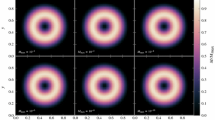Abstract
A new formulation for the numerical solution of low Mach number compressible flow problems is presented and analyzed. In this formulation the thermal part (energy and species equations) is solved implicitly and decoupled from the momentum equation, whereas the hydrodynamic part (momentum-continuity) is advanced in time using a high order splitting approach which results in overall high order accuracy in time and minimal errors in mass conservation. These errors are analyzed using both analytical tools and benchmark numerical examples. Results from two-dimensional simulations with one-step global reaction in opposed jet flame and porous particle configurations are also presented.
Similar content being viewed by others
REFERENCES
Behrendt, F., Goyal, G., Maas, U., and Warnatz, J. (1992). Numerical study of two-dimensional effects associated with laser-induced ignition in hydrogen-oxygen mixtures, 24th Int. Symp. Combust., The Combustion Institute, p. 83.
Bender, C. M., and Orszag, S. A. (1978). Adranced Mathematical Methods for Scientists and Engineers, McGraw-Hill Publ. Co.
Canuto, C., Hussaini, M., Quarteroni, A., and Zang, T. (1987). Spectral methods in Fluid Dynamics, Springer-Verlag.
Cho, S., Yetter, R., and Dryer, F. (1992). A computer model for one-dimensional mass and energy transport in and around chemically reacting particles, including complex gas-phase chemistry, multicomponent molecular diffusion, surface evaporation and heterogeneous reactions. J. Comput. Phys. 102, 160.
Chu, B. T., and Kovasznay, L. S. G. (1958). Non-linear interactions in a viscous heat-conducting compressible gas. J. Fluid Mech. 3, 494-514.
Dwyer, H. (1990). Calculation of low mach number reacting flows. AIAA 28, 99.
Dwyer, H., and Sanders, B. (1988). Calculations of unsteady reacting droplet flows. 22th Int. Symp. Combust., The Combustion Institute. p. 1923.
Ern, A., Douglas, C., and Smooke, M. (1994). Parallel computation of laminar diffusion flames. The Eastern States Section of the Combustion Institute. Dec 5–7. Clearwater Beach, Florida.
Gear, W. C. (1971). Numerical Initial Value Problems in ordinary Differential Equations, Prentice-Hall Publ. Co.
Gottlieb, D., and Orszag, S. A. (1977). Numerical Analysis of Spectral Methods: Theory and Applications. SIAM, Philadelphia, Pennsylvania.
Hindmarsh, A. C. (1983). ODEPACK, A systematized collections of ODE solvers. Scientific Computing. IMACS North-Holland Publ., pp. 55-64.
Karniadakis, G. E., Bullister, E. T., and Patera, A. T. (1985). A spectral element method for solution of two-and three-dimensional time dependent Navier-Stokes equations. Finite Element Methods for Nonlinear Problems, Springer-Verlag, p. 803.
Karniadakis, G. E., Israeli, M., and Orszag, S. A. (1991). High-order splitting methods for the incompressible Navier-Stokes equations. J. Comput. Phys. 97, 414.
Kee, R. J., Grear, M. D., and Miller, J. A. (1985). A fortran program for modeling steady laminar one-dimensional premixed flames, Sandia National Laboratory Report SAND85-8240.
Law, C. K. (1988). 22th Int. Symp. Combust., The Combustion Institute. pp. 1381-1402.
Lee, J. (1996). Simulations of two-dimensional chemically reactive flows. Ph.D. thesis, Princeton University.
Lee, J, Yetter, R., and Dryer, F. (1995). Transient numerical modeling of carbon particle ignition and oxidation. Combust. Flame 101, 387.
Lee, J. Yetter, R., and Dryer, F. (1996a). Numerical simulation of laser ignition of an isolated carbon particle in a quescent environment. Combust. Flame 105, 591.
Lee, J., Tomboulides, A. G., Orszag, S. A., Yetter, R., and Dryer, F. (1996b). A transient two-dimensional chemically reactive flow model: Fuel particle combustion in a nonquiescent environment. 26th Int. Symp. Combust., The Combustion Institute.
Lee, J., Tomboulides, A. G., Orszag, S. A., Yetter, R., and Dryer, F. (1997). Integrated asymptotic analysis and numerical simulation of laminar flow reactors. Combust. Sci. Tech., submitted.
Lutz, A. E., Kee, R. J., and Grear, J. F. (1994). Program for computing oppose-flow diffusion flames. Sandia National Laboratory Report.
Maday, Y., and Patera, A. T. (1987). Spectral element methods for the Navier-Stokes equations. ASME. State-of-the-Art Surreys in Computational Mechanics.
Megaridis, C., and Sirignano, W. (1992). Multicomponent droplet vaporization in a laminar convective environment. Combust. Sci. Tech. 87, 27.
Oran, E. S., and Boris, J. P. (1987). Numerical Simulation of Reactive Flow. Elsevier Science Publ. Co.
Orszag, S. A., Israeli, M., and Deville, M. O. (1986). Boundary conditions for incompressible flows. J. Sci. Comp. 1, 75.
Papas, P. (1995). Personal communication.
Patera, A. T. (1984). A spectral element method for fluid dynamics: Laminar flow in a channel expansion. J. Comput. Phys. 54, 468.
Patnaik, G., Kailasanath, K., Oran, E., and Laskey, K. (1988). Detailed numerical simulations of cellular flames. 22nd Int. Symp. Combust., The Combustion Institute, p. 1517.
Patnaik, G., Sirignano, W., Dwyer, H., and Sander, B. (1985). A numerical technique for the solution of a vaporizing fuel droplet. 10th Int. Colloquium on the Dynamics of Explosions and Reactive Systems, Berkeley, California.
Poinsot, T., Candel, S., and Trouve, A. (1996). Applications of direct numerical simulation to premixed turbulent combustion, Prog. Energy Combust. Sci. Pergamon Press, 21, 531-576.
Rehm, G. R., and Baum, H. R. (1978). The equations of motion for thermally driven flows. J. Res. National Bureau of Standards 83(3), 297-308.
Ronquist, E. M. (1988). Optimal spectral element methods for the unsteady three-dimensional incompressible Navier-Stokes equations. Ph.D. Thesis, Massachusetts Institute of Technology.
Sivashinsky, G. J. (1979). Hydrodynamics theory of flame propagation in an enclosed volume. Acta Astronautica 6, 631-645.
Smooke, M., Mitchell, R., and Keyes, D. (1989). Numerical solution of two-dimensional axisymmetric laminar diffusion flames. Combust. Sci. Tech. 67, 85.
Tomboulides, A. G., Israeli, M., and Karniadakis, G. E. (1989). Efficient removal of boundary-divergence errors in time-splitting methods. J. Sci. Comp. 4, 291.
Tomboulides, A. G., and Orszag, S. A. (1997). A quasi two-dimensional benchmark problem for low mach number compressible codes. (in press).
Williams, F. A. (1985). Combustion Theory, Benjamin Cummings Publ. Co. Second Edition.
Xu, Y., Smooke, M., and Long, M. (1993). Primitive variable modeling of multidimensional laminar flames. Combust. Sci. Tech. 90, 289.
Author information
Authors and Affiliations
Rights and permissions
About this article
Cite this article
Tomboulides, A.G., Lee, J.C.Y. & Orszag, S.A. Numerical Simulation of Low Mach Number Reactive Flows. Journal of Scientific Computing 12, 139–167 (1997). https://doi.org/10.1023/A:1025669715376
Issue Date:
DOI: https://doi.org/10.1023/A:1025669715376



